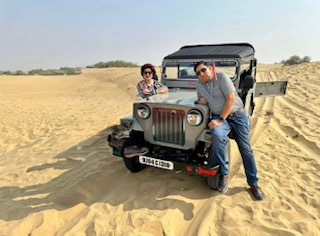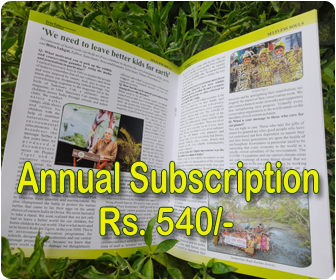Travelogue
Madhu Kumar
Rajasthan is the quintessential epitome of alluring colours, heroic tales of valour, age old rituals, time honoured customs, majestic forts, exquisite palaces, music that lingers in your ear long after the notes have faded and a cuisine that is a delicate amalgamation of taste and simplicity because traditionally not too many spices were available in this desert region to add complex dimensions to local dishes. This state, therefore, holds great appeal as a destination for vacations regardless of how many times one has visited it.
While discussing various options for a mini break, we decided to revisit Jaisalmer. Built of locally sourced limestone and sandstone, which inundate the city with a tawny glow, Jaisalmer is also famously called the Golden City.
This city lies on the western border of India in the very heart of the vast Thar Desert. In 1156, Maharawal Jaisal Singh established his new capital as a mud fort and named it Jaisalmer after himself. This region, at one time, was marked by trade routes which connected northern India to Persia and Arabia and extended as far as Egypt. Because of its location on this much-traversed route, Jaisalmer was the target of frequent attacks by foreign invaders. While the brave warriors of this kingdom battled valiantly and often claimed victory over their enemy, they nevertheless suffered defeat at times when their valour was insufficient to overpower the invaders. In such unfortunate situations, the ladies committed mass jauhar to escape humiliation and mistreatment at the hands of the marauding enemy. However, whenever pyres for jauhar proved to be insufficient, male relatives would put the womenfolk to the sword rather than allow them to fall into the clutches of the triumphant enemy soldiers.
As the plane began its descent, we saw below us the Golden City sprawled out in the tawny sands of the Thar. The frisson of excitement that coursed through us at this sight rivalled the thrill we experienced the very first time we saw it. Our hotel - in a manner similar to most of the local prominent buildings - was also built of locally sourced stone with elegant chhatris, graceful arches, deep verandas and massive courtyards with tinkling fountains that were reminiscent of royal residences. After a traditional teeka welcome with colourful folk dancers whirling and twirling around us to the beat of drums, we retired to our room to recharge our batteries.
As twilight descended gently on the city and the cloudless azure sky became streaked with soft hues of pink, lilac and gold as the sun sank into the west, we set out on a tour of Jaisalmer Fort. Also known as Swarn Durg, Sonar Quila or the Golden Fort, this majestic edifice, constructed of local sandstone, soars like a magical, fairy tale castle out of the sands and glows a rich honey gold. This is one of the few ‘living forts’ in the world and houses a large proportion of the population of the old city.
The area surrounding the fort teemed with a surge of humanity, with autos dextrously weaving their way in and out, with vendors calling out the colourful wares heaped on their carts or from where they squatted by the roadside while, wafting above it all like an invisible blanket, was the aroma of delicacies being fried in restaurants and in wayside shacks.
The winding, narrow road that leads up to the battlements is best manoeuvred in an auto; therefore, we flagged down the first unoccupied one we saw. The driver suggested we get a guide to accompany us and suggested one he knew well. Sumer Singh, our guide, sported a luxuriant moustache which he frequently twirled proudly and a colourful pagree that was in all probability unique to his clan.
When we reached the very top of the fort, he pointed out all the important landmarks that stretched out far below us and regaled us with interesting tales of past battles and events of historical significance. Thereafter, we strolled down, taking in the interesting sights and sounds of this bustling fort ‘city’. There were several shops along the way that displayed charming Rajasthani artefacts and colourful garments as well as houses where the residents nonchalantly went about their usual business, impervious to the stares of the passersby. An interesting feature that we discovered was a small painting of Ganeshji with a date underneath on the side of some of the doorways. This, we were informed by a helpful local, was a public invitation to a wedding in that particular house as personal invitations were difficult to dispatch. Our descent concluded with a spot of shopping followed by an immensely satisfying plate of delicious pakoras and piping hot tea.
The next morning we decided to visit Tanot Mata ka Mandir which is about 75 kilometres from Jaisalmer. The well-maintained road leading out of the city had nary a pothole to cause discomfort to the traveller and its smooth surface was absolutely amazing. This temple is devoted to Goddess Awad who is regarded as a warrior sage and is worshipped as Tanot Mata. It is renowned for the fact that all the bombs launched at it by the Pakistani forces during the 1965 and 1971 wars failed to detonate. Some of these bombs are displayed in the temple premises and the sight of them fills one with wonder at the divine intervention that prevented harm befalling the temple. Today, the management of the premises is in the very competent hands of the Border Security Force (BSF) and the darshan is completely hassle-free. Adjacent to the main temple is an area where there are colourful cloths and threads tied by devotees who send up prayers to the goddess to fulfil their wishes. The only caveat is that once this wish is fulfilled, the devotees must revisit the temple to untie any random knot indicating that their prayers have been heeded.
We thence moved onwards to the Indo-Pak border, which is not far from the temple. Along the way, we were greeted by the sight of several water reservoirs that had been constructed with a view to providing water to wandering cattle and camels when the area becomes devoid of water in the scorching summer months.
We had visited the border once before when we were allowed to step up close to the barbed wire that demarcates our territory. Glass bottles tied to the wires at regular intervals had aroused our curiosity then. We were informed by the gentleman accompanying us that these bottles are the best indicator of nighttime infiltration as they tinkle loudly when the wires are disturbed. We were curious too when we saw a tractor moving along the sand strip adjacent to the wires, dragging a flat board behind it. It was interesting to know that this board erases all marks and smoothens the sand so that the footprints of infiltrators stand out prominently. The BSF Watch Towers were, incidentally, operated by lady personnel during the day and by male personnel at night. Meeting these brave ladies was one of the highlights of our previous visit. This time, however, no one was permitted to go up to these Watch Towers as there was a boundary which could not be crossed by visitors. Yet, even this proximity to the border filled one with a huge surge of patriotism and immense respect for the brave hearts who guard our borders day and night without counting the cost to themselves.
We returned home the next day knowing that we had only explored a fraction of what this fascinating Golden City offers, yet content in the certain knowledge that this would certainly not be our last visit.
















Leave a comment